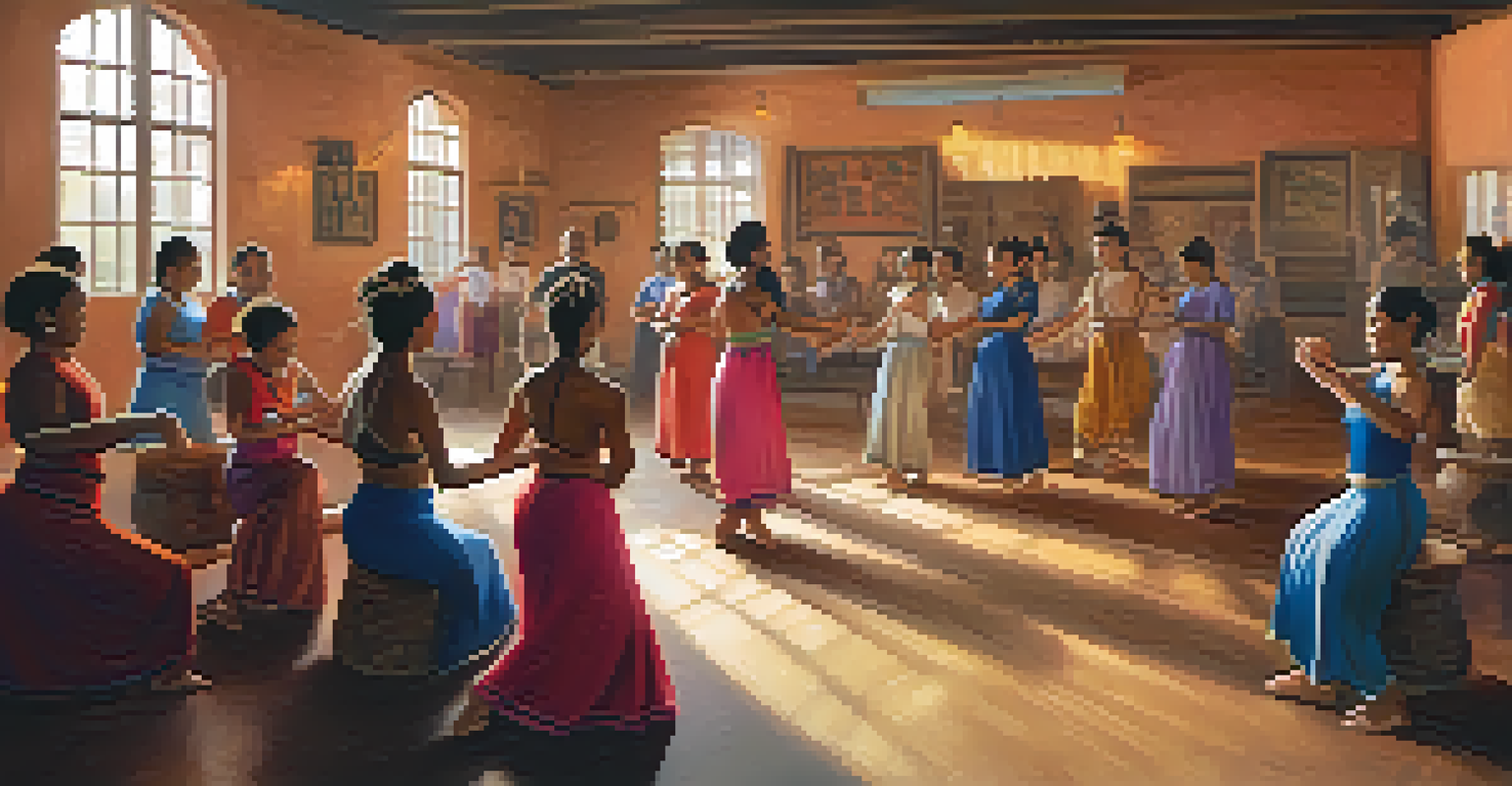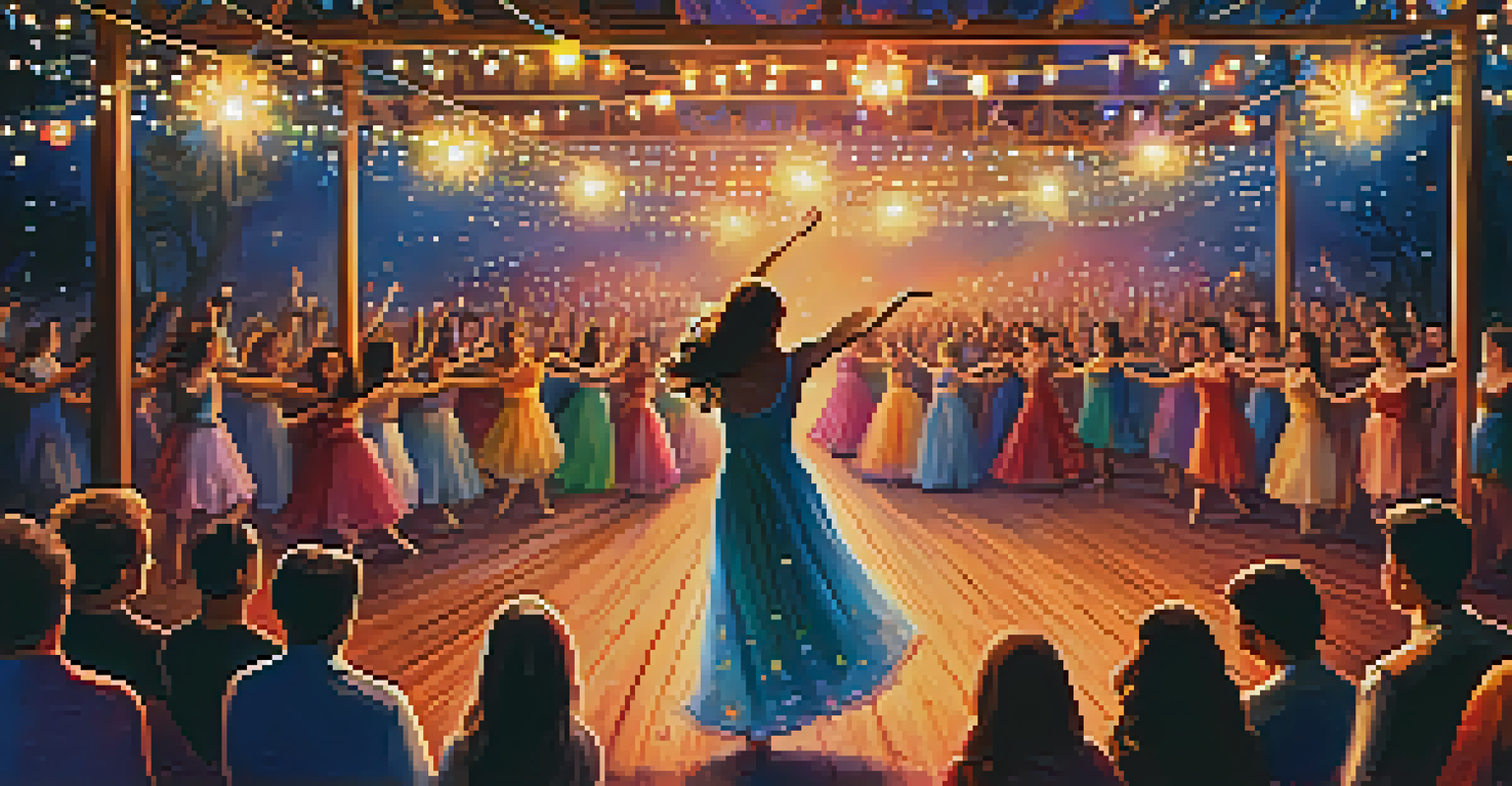Cultural Significance of Traditional Dance Festivals Today

The Role of Traditional Dance Festivals in Cultural Identity
Traditional dance festivals serve as a vibrant expression of cultural identity. They bring communities together, allowing individuals to celebrate their heritage through rhythm and movement. Just as a tapestry weaves together different threads, these festivals blend various cultural elements, showcasing the unique stories of each community.
Dance is the hidden language of the soul.
In many cultures, dance is not only an art form but also a means of storytelling. Each twirl, step, and gesture conveys historical narratives, ancestral wisdom, and shared values. For example, Native American powwows feature dances that honor the past, reinforcing a sense of belonging and pride among participants.
As globalization continues to influence cultural practices, traditional dance festivals become crucial in preserving these identities. They remind us of our roots and the importance of passing down traditions to future generations, ensuring that cultural legacies endure.
Reviving Cultural Heritage Through Dance
Many communities are revitalizing traditional dance forms as a way to reconnect with their cultural heritage. By organizing festivals, they create spaces where younger generations can learn and participate in these age-old practices. This revival not only keeps traditions alive but also instills a sense of pride among participants.

For instance, in India, festivals like Navratri feature Garba and Dandiya Raas, where people of all ages come together to dance. This collective celebration fosters community spirit and strengthens bonds, making the cultural experience richer and more meaningful.
Cultural Identity Through Dance
Traditional dance festivals celebrate and preserve cultural identities by bringing communities together to share their heritage.
Moreover, these festivals often attract tourists, providing an economic boost to local communities. As visitors engage with traditional dances, they gain insight into the culture, further promoting appreciation and understanding of diverse heritages.
The Impact of Technology on Dance Festivals
Technology has significantly transformed how traditional dance festivals are organized and experienced. Social media platforms allow for wider promotion, drawing larger audiences and increasing participation. This shift enables festivals to reach beyond local boundaries, creating a global appreciation for diverse dance forms.
Tradition is not the worship of ashes, but the preservation of fire.
Live streaming has also emerged as a game-changer, allowing those unable to attend in person to experience the festivities. For example, during the pandemic, many festivals adapted by broadcasting performances online, ensuring that the spirit of dance continued even in challenging times.
However, this technological shift comes with its challenges. As festivals embrace modernity, they must find a balance between tradition and innovation, ensuring that the core cultural values remain intact while also appealing to a broader audience.
Dance Festivals as Platforms for Social Change
Traditional dance festivals often serve as powerful platforms for social change. Through performances, communities can address important issues such as gender equality, environmental concerns, and cultural preservation. Dance becomes a medium for raising awareness and promoting dialogue.
For example, in many African nations, dance festivals highlight the roles of women in society, celebrating their strength and resilience. These performances can challenge stereotypes and inspire change, encouraging audiences to reflect on societal norms.
Community Engagement at Festivals
These festivals foster community involvement and inclusivity, strengthening bonds among participants and enhancing the cultural experience.
Moreover, festivals often collaborate with local NGOs to support various causes, creating a sense of unity and purpose. By intertwining cultural expression with activism, dance festivals can leave a lasting impact on both participants and spectators.
Community Engagement and Participation in Festivals
Community engagement is at the heart of traditional dance festivals, fostering a sense of belonging among participants. These events encourage locals to take part, whether through dancing, organizing, or volunteering. This active involvement strengthens community ties and enhances the overall festival experience.
For instance, in many Latin American countries, festivals like Carnaval invite everyone to join in the festivities, regardless of skill level. This inclusivity empowers individuals and enriches the cultural tapestry of the event.
Moreover, the collaborative spirit of these festivals often extends beyond dance, with local artists, musicians, and artisans showcasing their talents. This multifaceted approach not only boosts the local economy but also reinforces a shared cultural identity.
Educational Aspects of Traditional Dance Festivals
Traditional dance festivals are not just celebrations; they also serve an educational purpose. Many festivals include workshops and demonstrations that teach attendees about the history and significance of various dance forms. This educational component enriches the experience and fosters a deeper understanding of cultural practices.
For example, in dance festivals across Europe, workshops are often organized for young dancers to learn traditional styles from experienced performers. This hands-on approach encourages knowledge transfer and keeps traditions alive through practice.
Education and Cultural Exchange
Traditional dance festivals serve an educational purpose, offering workshops that promote the understanding and appreciation of diverse dance forms.
Additionally, these festivals can promote cultural exchange, where participants from different backgrounds share their dance traditions. This interaction cultivates respect and appreciation for diversity, enriching the cultural landscape for everyone involved.
The Future of Traditional Dance Festivals
As we look to the future, traditional dance festivals will continue to evolve while maintaining their cultural significance. The rise of hybrid festivals, combining in-person and virtual experiences, suggests an exciting direction for these events. This adaptability may attract even wider audiences and encourage greater participation.
Furthermore, as communities grapple with modern challenges, traditional dance may serve as a source of resilience and healing. Festivals can become spaces for collective reflection, allowing participants to process their experiences through the art of dance.

Ultimately, the enduring appeal of traditional dance festivals lies in their ability to unite people, celebrate diversity, and preserve cultural heritage. As they adapt to changing times, their fundamental role in fostering community and cultural pride remains timeless.